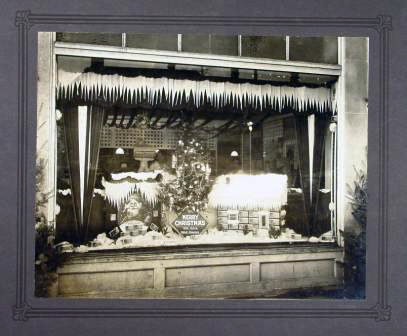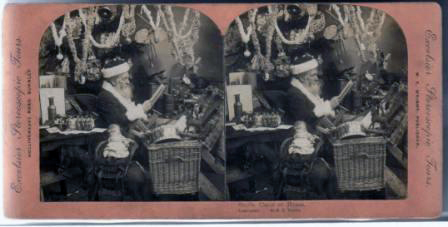 If you are looking for a real glimpse of Christmases past, photographs are your best bet. They can capture both the fantasy and the reality of the holiday.
If you are looking for a real glimpse of Christmases past, photographs are your best bet. They can capture both the fantasy and the reality of the holiday.
Cabinet photos of Christmas in the home are the most difficult to find. They are usually in the range of 4″ by 5″ to 8″ by 10″, mounted on grey or tan cardboard mounts, and produced by professional photographers who had to bring a large tripod-mounted camera into the home. They were relatively expensive at the time and are still expensive as collectors’ items. A large format photo of a late 19th or early 20th century home Christmas scene is a real treasure and a record of what was found both on and under the tree.
Probably the source of photos with the greatest variety is the photo postcard. The earliest are commercially produced greeting cards bearing scenes that were staged in photo studios using costumed actors. Some of the best are the hand-tinted French or German postcards that feature long-bearded old men who really look the part of Father Christmas. They are also a great source of images of period toys. Real photo postcards also show up as one-of-a-kind home snapshots of the kids in front of the Christmas tree. Eastman Kodak introduced a folding bellows camera in 1903 that allowed anyone to make a postcard. The roll of film was mailed to the Kodak labs to be printed directly onto photo paper that was pre-printed with a postcard back.
 Stereo views are limited in terms of variety but are available in relatively large numbers because many were mass-produced in the 19th and early 20th centuries. A large collection of Christmas-themed stereographs may still be fewer than fifty cards. However, because of the third-dimensional factor, the stereoscope is also a great time-machine to take the user back to the place that is pictured and allow him or her to visually move into the scene and study it in detail. Unfortunately, because of the demands of the equipment and the glass-plate negatives, most of these are staged scenes – often with painted backdrops rather than real rooms. The spontaneity and authenticity of a snapshot is lost in order to gain the illusion of reality that a good stereo view can provide. And what is Christmas without a healthy dose of illusion?
Stereo views are limited in terms of variety but are available in relatively large numbers because many were mass-produced in the 19th and early 20th centuries. A large collection of Christmas-themed stereographs may still be fewer than fifty cards. However, because of the third-dimensional factor, the stereoscope is also a great time-machine to take the user back to the place that is pictured and allow him or her to visually move into the scene and study it in detail. Unfortunately, because of the demands of the equipment and the glass-plate negatives, most of these are staged scenes – often with painted backdrops rather than real rooms. The spontaneity and authenticity of a snapshot is lost in order to gain the illusion of reality that a good stereo view can provide. And what is Christmas without a healthy dose of illusion?
